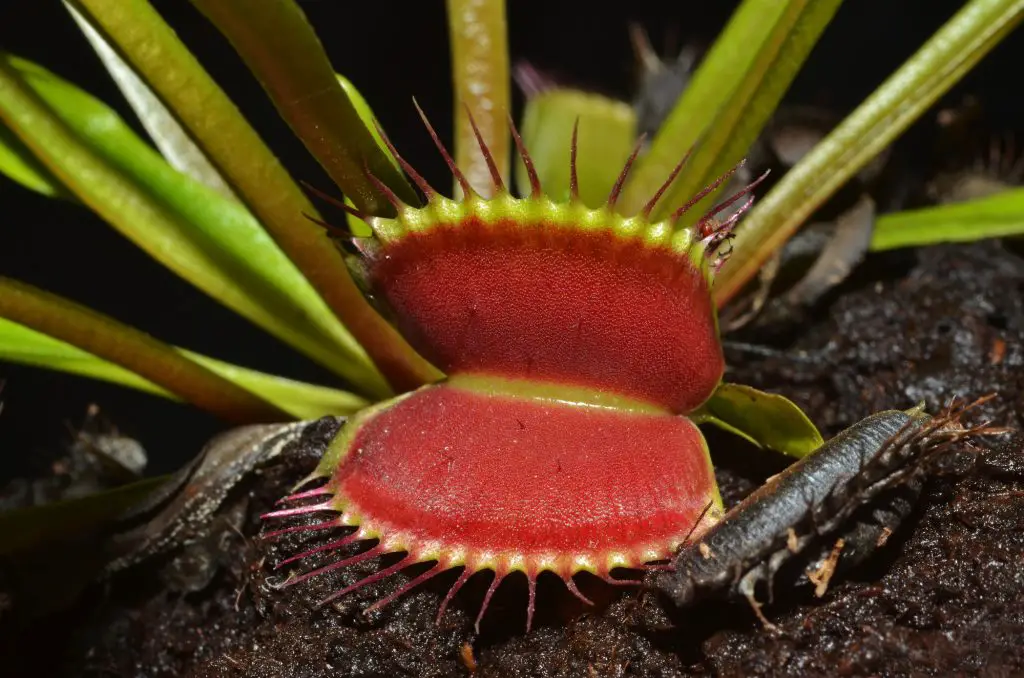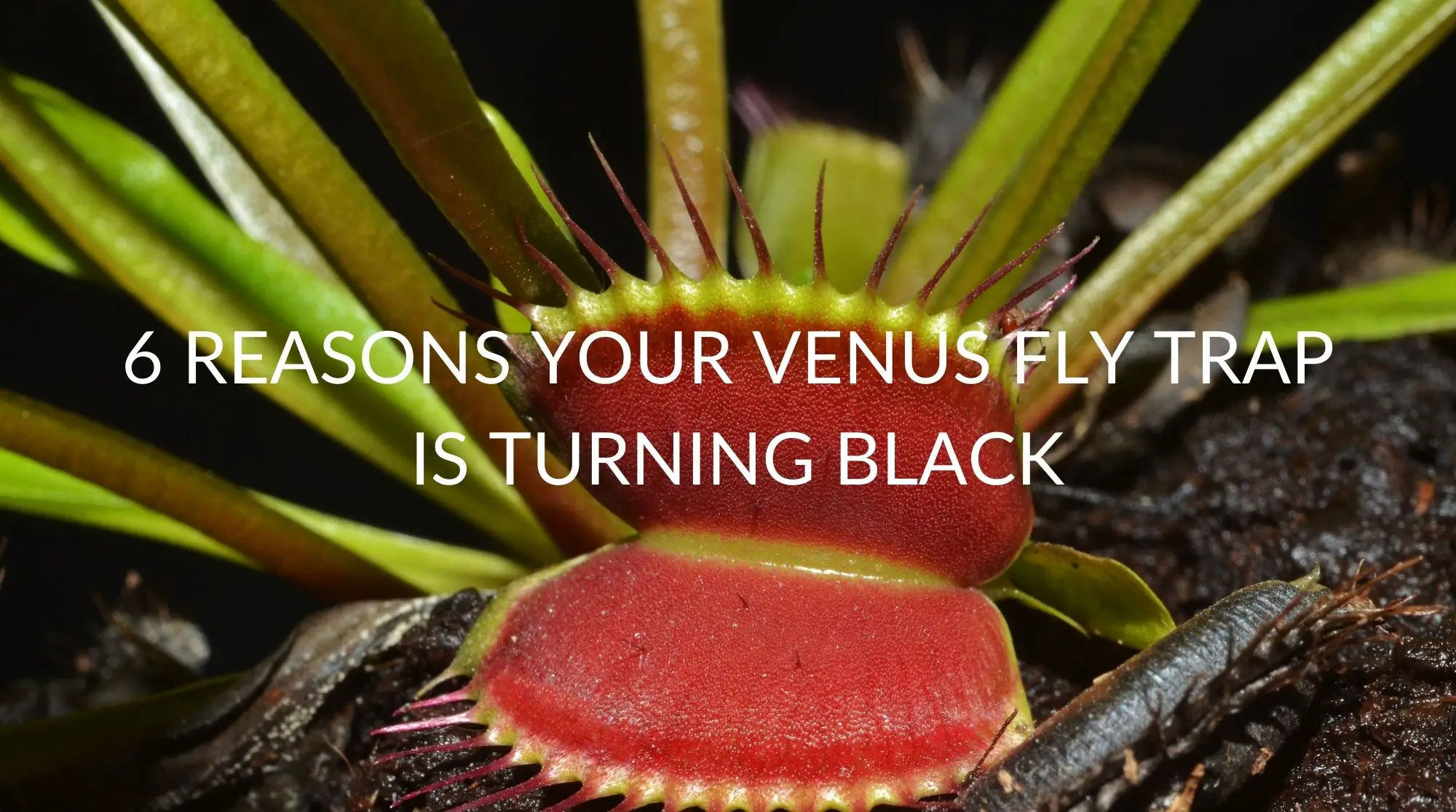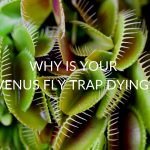It is normal for venus flytraps to turn black when they suffer from a lack of nutrients, especially during winter when they go through their winter dormancy. During winter dormancy, the plant begins dying as it copes with nutrient deficiencies. There are many other instances where the Venus flytrap struggles with nutrient deficiency, thus causing its leaves to turn black and start dying.
This article discusses how turning black is normal for the Venus flytrap. Continue reading to learn why venus flytraps turn black and how to cope with blackening flytrap leaves.
Is It Normal For Venus Flytraps To Turn Black?
It is normal for venus flytrap leaves and traps to turn black as the plants experience a lack of nutrients, water, or other substances. Most Venus flytraps will turn black at one point from natural causes, and it is nothing to be concerned about. The blackening of leaves and traps can be easily fixed by adjusting your diet or paying closer attention to your plant’s environment.
There are many normal reasons that Venus flytraps will turn black, and not every reason means your plant is dying. One of the most common reasons Venus flytraps turn black is going through winter dormancy. The winter dormancy stage is a phase of the plant’s life when they are resting. They do not absorb food during this time or absorb water, thus making the plant’s leaves, flowers, and traps die.
In most cases, you do not need to do anything about your Venus flytrap’s leaves turning black except prune the leaves from the plant. Pruning leaves can be great to produce the healthiest plant possible. However, the Venus flytrap will remain dormant through winter, so you should not expect the plant to rebloom until spring.

Why Is Your Venus Fly Trap Turning Black?
When leaves or traps turn black, it can signify that the plant is dying. It can die from unsustainable soil with poor irrigation or an inadequate diet. Evaluate your plant to see if you need to adjust anything.
The most common reason Venus flytrap leaves begin dying and turn black is not receiving enough water or nutrients. It would help if you gave your plant a close physical examination to identify potential physical problems when the leaves turn black. Adjusting watering and feeding routines can help your Venus flytrap.
Inedible Objects
The Venus flytrap’s trap may turn black when it closes around an inedible object like a stem or rock. As the Venus flytrap attempts to take nutrients from the food, it dies because there are no nutrients to consume. The carnivorous plant will expel all its energy in the dying trap, causing surrounding leaves to blacken and die.
Winter dormancy
Venus flytraps turn black each winter during their dormancy period as food and sun become less available. The Venus flytrap conserves its nutrients by blackening its leaves and traps during this dormancy period. The stems and roots typically remain green so they can rebloom in the following spring.
Dying
It is normal for Venus flytraps to turn black when they die because they are deprived of nutrients. The plant will change from green or red as they become nutrient-deprived, and the leaves will slowly turn black. There are many reasons plants die, but the most common reason is raising your plants in unacceptable conditions.
Inadequate Diet
Venus flytraps are particular about their carnivorous diets, blackening around inedible objects or food that does not fit their dietary needs. Venus flytraps require a specific diet consisting of bugs like flies, spiders, and beetles. Feeding them the wrong diet will cause them to blacken on the leaves, especially around inedible objects.
Overfeeding
Overfeeding your Venus flytrap can cause the traps of your plant to turn black because it causes nutrient overdose. Nutrient overdose is as problematic as nutrient deficiency. So, you should take it very seriously. A venus flytrap should consume, at maximum, no more than one or two bugs every two weeks. Reduce their feeding routine if you see blackening after feeding your Venus flytraps.
Inadequate Soil
Venus flytraps grow best in nutrient-poor soil with no minerals. Planting a Venus flytrap in soil with nutrients will most likely kill the plant, starting with the blackening of leaves. Furthermore, the soil you use should also have excellent drainage. Never give your Venus flytrap fertilizer, or the nutrients in this will cause your leaves to turn black.
How To Deal With a Venus Fly Trap Turning Black?
There are many ways to help a Venus flytrap that is turning black. It is normal for the leaves of your Venus flytraps to turn black during winter and then turn green again in the following spring. It would help best if you immediately pruned your Venus flytrap leaves when they turn black.
To determine your best course of action after pruning the black leaves from your Venus flytrap, observe the conditions of your soil and the reaction of your plant after the typical watering and feeding routine.
You do not need to prune black leaves from your Venus flytrap if you do not want to. Still, it would help to prune them away to guarantee they are not absorbing any of your plant’s necessary nutrients. Pruning your leaves allows your Venus flytrap plant to rebloom, especially the tall flower at the center of the plant, which only blooms once every spring.
Adjust Diet
Evaluate your Venus flytrap’s diet and adjust it accordingly. If you are not feeding your Venus flytrap one bug every one or two weeks, you should adjust their diet. You might also need to feed your Venus flytrap a different diet. Venus flytraps require a strict diet of beetles, spiders, flies, and other insects. If you are feeding them anything else, you should adjust it to meet their needs.
Wait Out the Season
If changing seasons are the reason your Venus flytrap is turning black, there is not much that you should do to fix your Venus flytrap. To help a plant’s black leaves during winter dormancy, what you must do is wait for winter to end. Once the season changes, the color should return to your plant.
Prune Leaves
Pruning leaves is the first step to fixing black Venus flytrap leaves. Pruning is when you remove dead or dying leaves from a plant so they no longer take nutrients from it. Your Venus flytrap has a better chance of flourishing after pruning the dead leaves or traps because it no longer starves your Venus flytrap of its nutrients.
Change Soil
Change your Venus flytrap’s soil to accommodate its needs, and you will notice the plant’s leaves return to their natural color. Use aerated, nutrient-deprived soil to allow your Venus flytrap to drain water and grow efficiently. You can purchase soil at any gardening store. Gardening specialists can offer recommendations on the best soil for your Venus flytrap.
Should You Cut Off Black Venus Fly Traps?
Cutting off, or pruning, the black leaves, and traps from your Venus flytraps is a great idea because it will prevent the dead parts of your plant from absorbing nutrients. If you do not prune your Venus flytrap, your plant will waste nutrients by unevenly distributing them to both the living and the dead leaves. When plants waste nutrients by unevenly distributing them, other leaves will begin to turn black.
Pruning leaves allows for even nutrient distribution. After feeding your plant, your plant will evenly distribute the food throughout the living leaves rather than giving any nutrients to the dead leaves. The even nutrient distribution helps the plants flourish, giving the Venus flytrap its bright green and red color. This nutrient distribution also helps the plant grow its beautiful flower.
Pruning is an easy and quick process that can help your plant grow better. Use a pair of gardening shears or sharp scissors to cut your leaves below the black area. Cutting right above the living area will allow the plant to regrow. If your Venus flytrap is black everywhere, your plant is dead.
Recap
Venus flytraps turn black because they are nutrient-deprived, like during winter dormancy. When the Venus flytrap’s leaves turn black, you should prune them away so the remaining plant may continue to thrive. Otherwise, your Venus flytrap will waste all of its energy while absorbing food in the wrong traps and leaves.
Never worry if your Venus flytrap’s leaves turn black, but you should at least pay attention to them. Black leaves show that your plant is going through a change, and potentially something is wrong with your plant. You should monitor your Venus flytrap closely, especially near their feeding schedule to identify whether your feeding routine affects your plant’s health.
If you feed your Venus flytrap more than once every two weeks, you should try to limit the amount you feed your Venus flytrap. Overfeeding your Venus flytrap can cause the leaves to turn black. Prune your Venus flytrap’s leaves so your Venus flytrap can distribute its nutrients evenly and get the nutrients it needs in the right places.








